Medical Errors: Incident Analysis, Nurse's Role, and Prevention
VerifiedAdded on 2022/09/22
|6
|1485
|18
Report
AI Summary
This report presents a detailed analysis of a medical error incident where a patient allegedly died due to a nurse crushing and injecting three oral tablets into an IV drip. The report describes the incident, focusing on the nurse's actions and the patient's demise. It discusses the consequences of the error for the patient, the nurse, and the family, highlighting potential legal and emotional impacts. The report also explores nursing actions and interventions, such as clinical governance and medication safety protocols, to prevent similar errors. It emphasizes the importance of a culture of patient safety and the application of the '5 rights' of medication administration. The writer reflects on the incident, expressing sadness and sympathy, while also critiquing the nurse's actions. The report concludes by reiterating the prevalence of medical errors, their impact, and the need for proactive measures to improve patient safety and healthcare outcomes. The assignment is a comprehensive study of the incident and its implications.
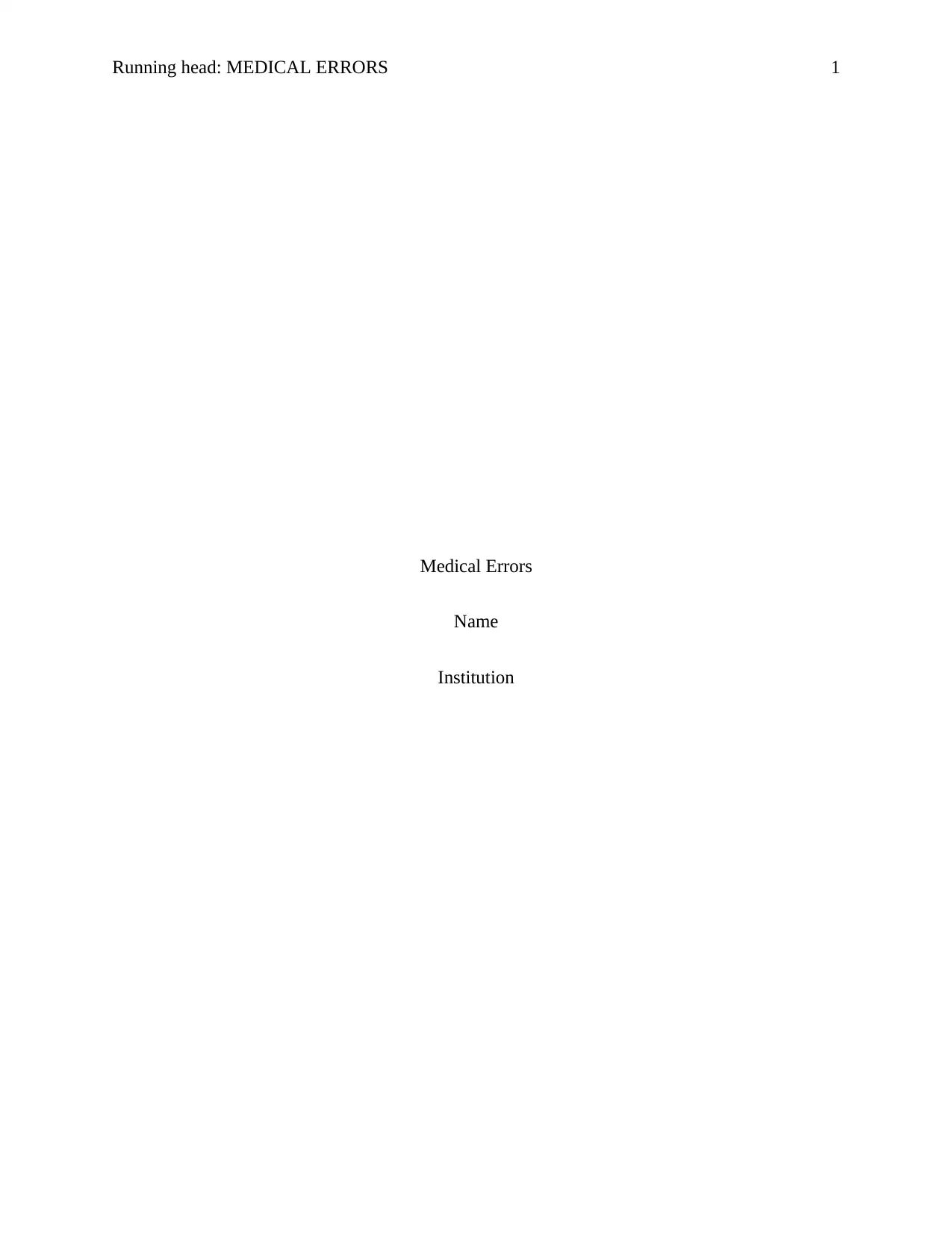
Running head: MEDICAL ERRORS 1
Medical Errors
Name
Institution
Medical Errors
Name
Institution
Paraphrase This Document
Need a fresh take? Get an instant paraphrase of this document with our AI Paraphraser
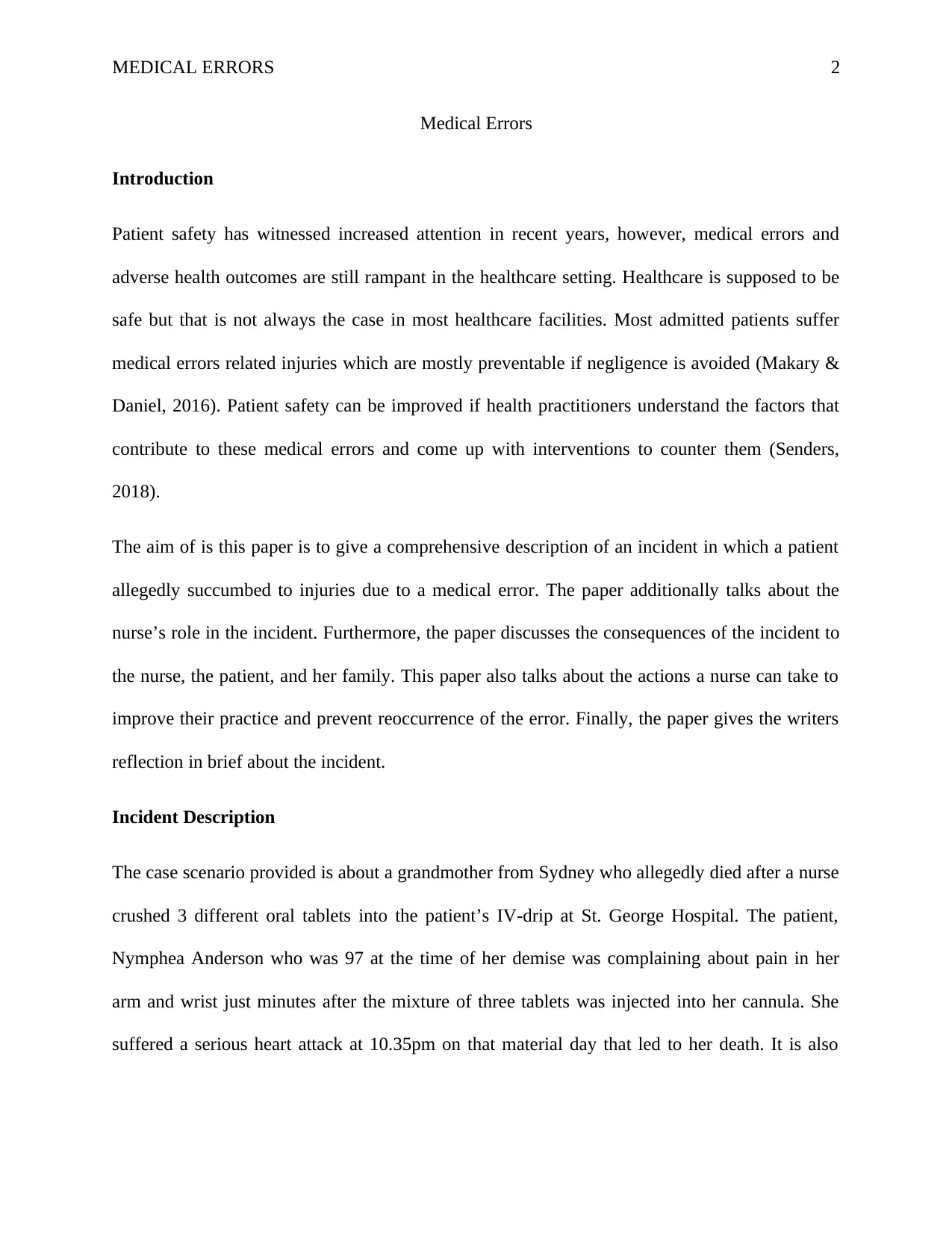
MEDICAL ERRORS 2
Medical Errors
Introduction
Patient safety has witnessed increased attention in recent years, however, medical errors and
adverse health outcomes are still rampant in the healthcare setting. Healthcare is supposed to be
safe but that is not always the case in most healthcare facilities. Most admitted patients suffer
medical errors related injuries which are mostly preventable if negligence is avoided (Makary &
Daniel, 2016). Patient safety can be improved if health practitioners understand the factors that
contribute to these medical errors and come up with interventions to counter them (Senders,
2018).
The aim of is this paper is to give a comprehensive description of an incident in which a patient
allegedly succumbed to injuries due to a medical error. The paper additionally talks about the
nurse’s role in the incident. Furthermore, the paper discusses the consequences of the incident to
the nurse, the patient, and her family. This paper also talks about the actions a nurse can take to
improve their practice and prevent reoccurrence of the error. Finally, the paper gives the writers
reflection in brief about the incident.
Incident Description
The case scenario provided is about a grandmother from Sydney who allegedly died after a nurse
crushed 3 different oral tablets into the patient’s IV-drip at St. George Hospital. The patient,
Nymphea Anderson who was 97 at the time of her demise was complaining about pain in her
arm and wrist just minutes after the mixture of three tablets was injected into her cannula. She
suffered a serious heart attack at 10.35pm on that material day that led to her death. It is also
Medical Errors
Introduction
Patient safety has witnessed increased attention in recent years, however, medical errors and
adverse health outcomes are still rampant in the healthcare setting. Healthcare is supposed to be
safe but that is not always the case in most healthcare facilities. Most admitted patients suffer
medical errors related injuries which are mostly preventable if negligence is avoided (Makary &
Daniel, 2016). Patient safety can be improved if health practitioners understand the factors that
contribute to these medical errors and come up with interventions to counter them (Senders,
2018).
The aim of is this paper is to give a comprehensive description of an incident in which a patient
allegedly succumbed to injuries due to a medical error. The paper additionally talks about the
nurse’s role in the incident. Furthermore, the paper discusses the consequences of the incident to
the nurse, the patient, and her family. This paper also talks about the actions a nurse can take to
improve their practice and prevent reoccurrence of the error. Finally, the paper gives the writers
reflection in brief about the incident.
Incident Description
The case scenario provided is about a grandmother from Sydney who allegedly died after a nurse
crushed 3 different oral tablets into the patient’s IV-drip at St. George Hospital. The patient,
Nymphea Anderson who was 97 at the time of her demise was complaining about pain in her
arm and wrist just minutes after the mixture of three tablets was injected into her cannula. She
suffered a serious heart attack at 10.35pm on that material day that led to her death. It is also
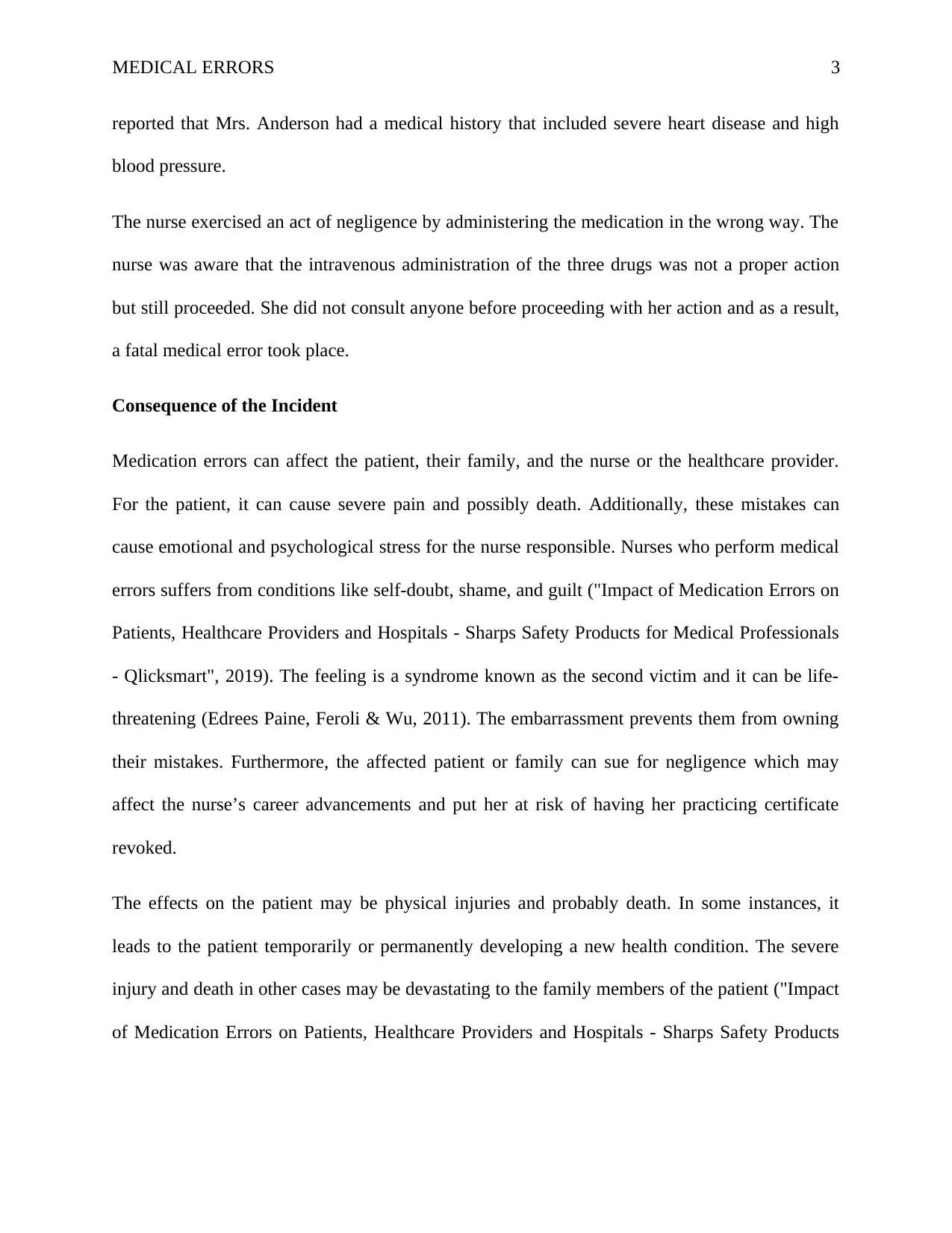
MEDICAL ERRORS 3
reported that Mrs. Anderson had a medical history that included severe heart disease and high
blood pressure.
The nurse exercised an act of negligence by administering the medication in the wrong way. The
nurse was aware that the intravenous administration of the three drugs was not a proper action
but still proceeded. She did not consult anyone before proceeding with her action and as a result,
a fatal medical error took place.
Consequence of the Incident
Medication errors can affect the patient, their family, and the nurse or the healthcare provider.
For the patient, it can cause severe pain and possibly death. Additionally, these mistakes can
cause emotional and psychological stress for the nurse responsible. Nurses who perform medical
errors suffers from conditions like self-doubt, shame, and guilt ("Impact of Medication Errors on
Patients, Healthcare Providers and Hospitals - Sharps Safety Products for Medical Professionals
- Qlicksmart", 2019). The feeling is a syndrome known as the second victim and it can be life-
threatening (Edrees Paine, Feroli & Wu, 2011). The embarrassment prevents them from owning
their mistakes. Furthermore, the affected patient or family can sue for negligence which may
affect the nurse’s career advancements and put her at risk of having her practicing certificate
revoked.
The effects on the patient may be physical injuries and probably death. In some instances, it
leads to the patient temporarily or permanently developing a new health condition. The severe
injury and death in other cases may be devastating to the family members of the patient ("Impact
of Medication Errors on Patients, Healthcare Providers and Hospitals - Sharps Safety Products
reported that Mrs. Anderson had a medical history that included severe heart disease and high
blood pressure.
The nurse exercised an act of negligence by administering the medication in the wrong way. The
nurse was aware that the intravenous administration of the three drugs was not a proper action
but still proceeded. She did not consult anyone before proceeding with her action and as a result,
a fatal medical error took place.
Consequence of the Incident
Medication errors can affect the patient, their family, and the nurse or the healthcare provider.
For the patient, it can cause severe pain and possibly death. Additionally, these mistakes can
cause emotional and psychological stress for the nurse responsible. Nurses who perform medical
errors suffers from conditions like self-doubt, shame, and guilt ("Impact of Medication Errors on
Patients, Healthcare Providers and Hospitals - Sharps Safety Products for Medical Professionals
- Qlicksmart", 2019). The feeling is a syndrome known as the second victim and it can be life-
threatening (Edrees Paine, Feroli & Wu, 2011). The embarrassment prevents them from owning
their mistakes. Furthermore, the affected patient or family can sue for negligence which may
affect the nurse’s career advancements and put her at risk of having her practicing certificate
revoked.
The effects on the patient may be physical injuries and probably death. In some instances, it
leads to the patient temporarily or permanently developing a new health condition. The severe
injury and death in other cases may be devastating to the family members of the patient ("Impact
of Medication Errors on Patients, Healthcare Providers and Hospitals - Sharps Safety Products
⊘ This is a preview!⊘
Do you want full access?
Subscribe today to unlock all pages.

Trusted by 1+ million students worldwide
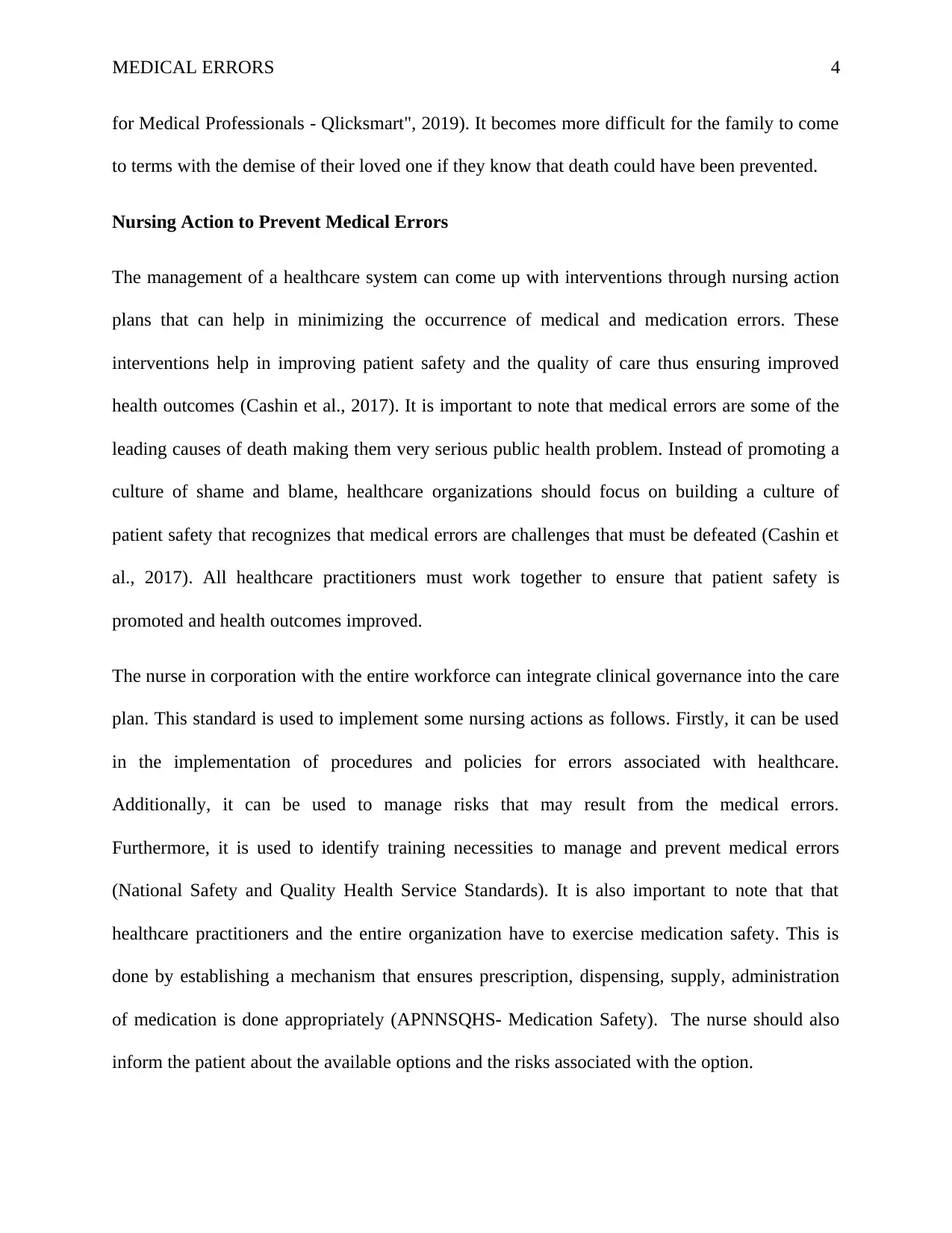
MEDICAL ERRORS 4
for Medical Professionals - Qlicksmart", 2019). It becomes more difficult for the family to come
to terms with the demise of their loved one if they know that death could have been prevented.
Nursing Action to Prevent Medical Errors
The management of a healthcare system can come up with interventions through nursing action
plans that can help in minimizing the occurrence of medical and medication errors. These
interventions help in improving patient safety and the quality of care thus ensuring improved
health outcomes (Cashin et al., 2017). It is important to note that medical errors are some of the
leading causes of death making them very serious public health problem. Instead of promoting a
culture of shame and blame, healthcare organizations should focus on building a culture of
patient safety that recognizes that medical errors are challenges that must be defeated (Cashin et
al., 2017). All healthcare practitioners must work together to ensure that patient safety is
promoted and health outcomes improved.
The nurse in corporation with the entire workforce can integrate clinical governance into the care
plan. This standard is used to implement some nursing actions as follows. Firstly, it can be used
in the implementation of procedures and policies for errors associated with healthcare.
Additionally, it can be used to manage risks that may result from the medical errors.
Furthermore, it is used to identify training necessities to manage and prevent medical errors
(National Safety and Quality Health Service Standards). It is also important to note that that
healthcare practitioners and the entire organization have to exercise medication safety. This is
done by establishing a mechanism that ensures prescription, dispensing, supply, administration
of medication is done appropriately (APNNSQHS- Medication Safety). The nurse should also
inform the patient about the available options and the risks associated with the option.
for Medical Professionals - Qlicksmart", 2019). It becomes more difficult for the family to come
to terms with the demise of their loved one if they know that death could have been prevented.
Nursing Action to Prevent Medical Errors
The management of a healthcare system can come up with interventions through nursing action
plans that can help in minimizing the occurrence of medical and medication errors. These
interventions help in improving patient safety and the quality of care thus ensuring improved
health outcomes (Cashin et al., 2017). It is important to note that medical errors are some of the
leading causes of death making them very serious public health problem. Instead of promoting a
culture of shame and blame, healthcare organizations should focus on building a culture of
patient safety that recognizes that medical errors are challenges that must be defeated (Cashin et
al., 2017). All healthcare practitioners must work together to ensure that patient safety is
promoted and health outcomes improved.
The nurse in corporation with the entire workforce can integrate clinical governance into the care
plan. This standard is used to implement some nursing actions as follows. Firstly, it can be used
in the implementation of procedures and policies for errors associated with healthcare.
Additionally, it can be used to manage risks that may result from the medical errors.
Furthermore, it is used to identify training necessities to manage and prevent medical errors
(National Safety and Quality Health Service Standards). It is also important to note that that
healthcare practitioners and the entire organization have to exercise medication safety. This is
done by establishing a mechanism that ensures prescription, dispensing, supply, administration
of medication is done appropriately (APNNSQHS- Medication Safety). The nurse should also
inform the patient about the available options and the risks associated with the option.
Paraphrase This Document
Need a fresh take? Get an instant paraphrase of this document with our AI Paraphraser
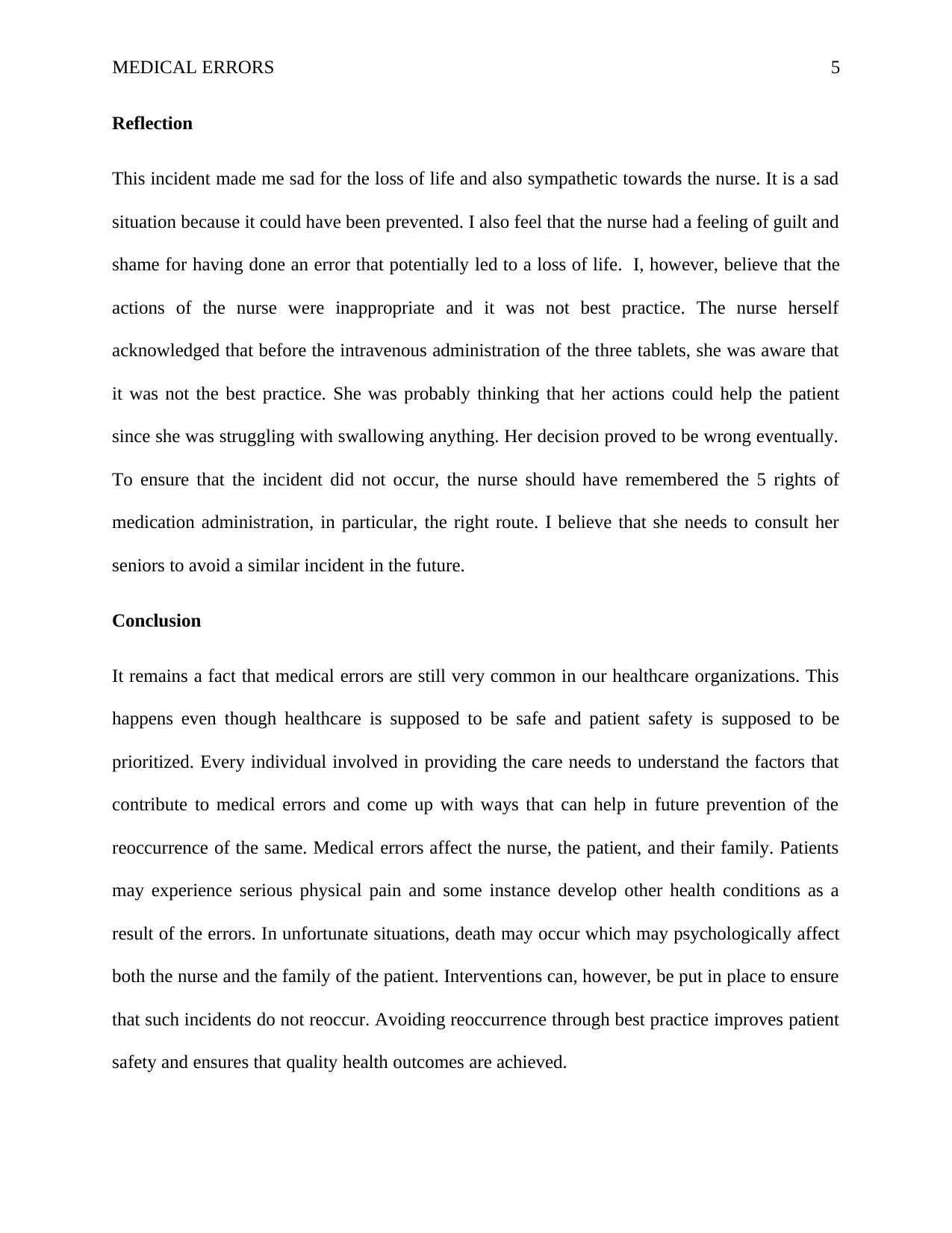
MEDICAL ERRORS 5
Reflection
This incident made me sad for the loss of life and also sympathetic towards the nurse. It is a sad
situation because it could have been prevented. I also feel that the nurse had a feeling of guilt and
shame for having done an error that potentially led to a loss of life. I, however, believe that the
actions of the nurse were inappropriate and it was not best practice. The nurse herself
acknowledged that before the intravenous administration of the three tablets, she was aware that
it was not the best practice. She was probably thinking that her actions could help the patient
since she was struggling with swallowing anything. Her decision proved to be wrong eventually.
To ensure that the incident did not occur, the nurse should have remembered the 5 rights of
medication administration, in particular, the right route. I believe that she needs to consult her
seniors to avoid a similar incident in the future.
Conclusion
It remains a fact that medical errors are still very common in our healthcare organizations. This
happens even though healthcare is supposed to be safe and patient safety is supposed to be
prioritized. Every individual involved in providing the care needs to understand the factors that
contribute to medical errors and come up with ways that can help in future prevention of the
reoccurrence of the same. Medical errors affect the nurse, the patient, and their family. Patients
may experience serious physical pain and some instance develop other health conditions as a
result of the errors. In unfortunate situations, death may occur which may psychologically affect
both the nurse and the family of the patient. Interventions can, however, be put in place to ensure
that such incidents do not reoccur. Avoiding reoccurrence through best practice improves patient
safety and ensures that quality health outcomes are achieved.
Reflection
This incident made me sad for the loss of life and also sympathetic towards the nurse. It is a sad
situation because it could have been prevented. I also feel that the nurse had a feeling of guilt and
shame for having done an error that potentially led to a loss of life. I, however, believe that the
actions of the nurse were inappropriate and it was not best practice. The nurse herself
acknowledged that before the intravenous administration of the three tablets, she was aware that
it was not the best practice. She was probably thinking that her actions could help the patient
since she was struggling with swallowing anything. Her decision proved to be wrong eventually.
To ensure that the incident did not occur, the nurse should have remembered the 5 rights of
medication administration, in particular, the right route. I believe that she needs to consult her
seniors to avoid a similar incident in the future.
Conclusion
It remains a fact that medical errors are still very common in our healthcare organizations. This
happens even though healthcare is supposed to be safe and patient safety is supposed to be
prioritized. Every individual involved in providing the care needs to understand the factors that
contribute to medical errors and come up with ways that can help in future prevention of the
reoccurrence of the same. Medical errors affect the nurse, the patient, and their family. Patients
may experience serious physical pain and some instance develop other health conditions as a
result of the errors. In unfortunate situations, death may occur which may psychologically affect
both the nurse and the family of the patient. Interventions can, however, be put in place to ensure
that such incidents do not reoccur. Avoiding reoccurrence through best practice improves patient
safety and ensures that quality health outcomes are achieved.
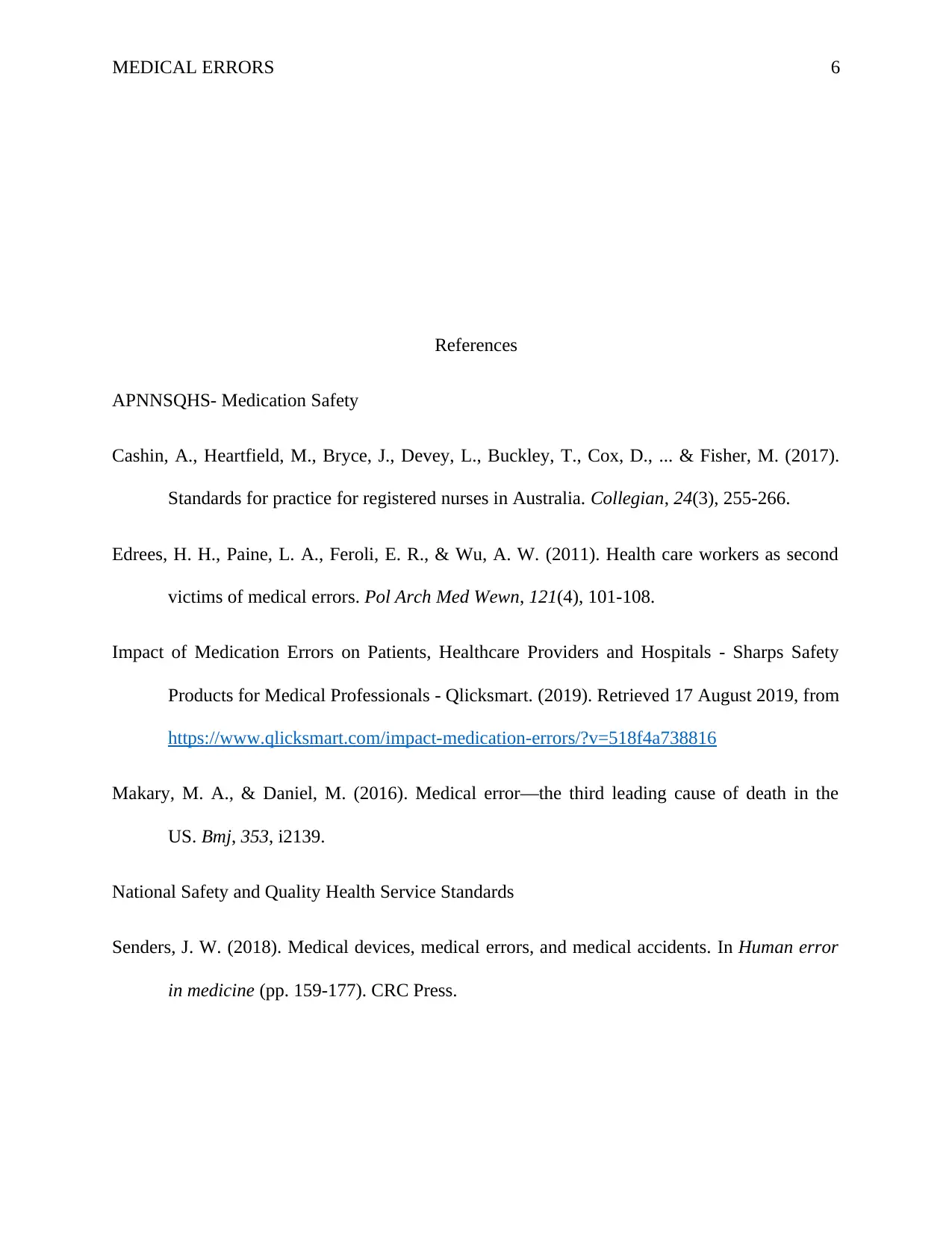
MEDICAL ERRORS 6
References
APNNSQHS- Medication Safety
Cashin, A., Heartfield, M., Bryce, J., Devey, L., Buckley, T., Cox, D., ... & Fisher, M. (2017).
Standards for practice for registered nurses in Australia. Collegian, 24(3), 255-266.
Edrees, H. H., Paine, L. A., Feroli, E. R., & Wu, A. W. (2011). Health care workers as second
victims of medical errors. Pol Arch Med Wewn, 121(4), 101-108.
Impact of Medication Errors on Patients, Healthcare Providers and Hospitals - Sharps Safety
Products for Medical Professionals - Qlicksmart. (2019). Retrieved 17 August 2019, from
https://www.qlicksmart.com/impact-medication-errors/?v=518f4a738816
Makary, M. A., & Daniel, M. (2016). Medical error—the third leading cause of death in the
US. Bmj, 353, i2139.
National Safety and Quality Health Service Standards
Senders, J. W. (2018). Medical devices, medical errors, and medical accidents. In Human error
in medicine (pp. 159-177). CRC Press.
References
APNNSQHS- Medication Safety
Cashin, A., Heartfield, M., Bryce, J., Devey, L., Buckley, T., Cox, D., ... & Fisher, M. (2017).
Standards for practice for registered nurses in Australia. Collegian, 24(3), 255-266.
Edrees, H. H., Paine, L. A., Feroli, E. R., & Wu, A. W. (2011). Health care workers as second
victims of medical errors. Pol Arch Med Wewn, 121(4), 101-108.
Impact of Medication Errors on Patients, Healthcare Providers and Hospitals - Sharps Safety
Products for Medical Professionals - Qlicksmart. (2019). Retrieved 17 August 2019, from
https://www.qlicksmart.com/impact-medication-errors/?v=518f4a738816
Makary, M. A., & Daniel, M. (2016). Medical error—the third leading cause of death in the
US. Bmj, 353, i2139.
National Safety and Quality Health Service Standards
Senders, J. W. (2018). Medical devices, medical errors, and medical accidents. In Human error
in medicine (pp. 159-177). CRC Press.
⊘ This is a preview!⊘
Do you want full access?
Subscribe today to unlock all pages.

Trusted by 1+ million students worldwide
1 out of 6
Related Documents
Your All-in-One AI-Powered Toolkit for Academic Success.
+13062052269
info@desklib.com
Available 24*7 on WhatsApp / Email
![[object Object]](/_next/static/media/star-bottom.7253800d.svg)
Unlock your academic potential
Copyright © 2020–2025 A2Z Services. All Rights Reserved. Developed and managed by ZUCOL.





